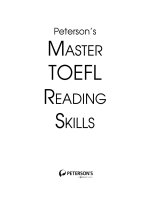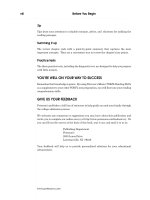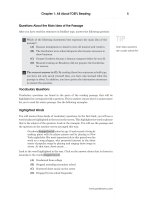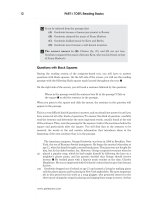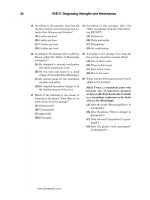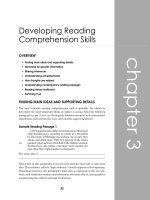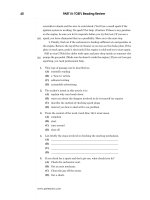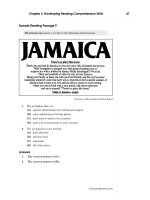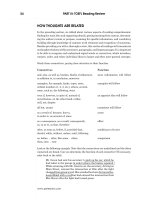IVY’s LISTENNING TOEFL
Bạn đang xem bản rút gọn của tài liệu. Xem và tải ngay bản đầy đủ của tài liệu tại đây (1.3 MB, 594 trang )
IVY’s LISTENNING TOEFL
IVY’s LISTENNING TOEFL
15 Actual Tests
Koh Myounghee, Part Younghwal,
Part Kyubyong, Choi Eunjung, Lee Hyunju
Carey Groleau, Henry John Amen IV
iBT TOEFL Real-Level
Now concentrate on taking the 10 Actual Test sets that are at the same
level and accompanied by the same questions types as those on the real iBT
TOEFL test. These Real-Level Actual Tests are based on numerous in-depth
analyses of the real test. After these Actual Tests, you’ll easily be able to keep up
with the real iBT TOEFL test. We suggest that you take these Actual Tests under
conditions that are similar as possible to real test conditions.
Actual Test 1.
Section Directions
This section measures your ability to understand conversations and
lectures in English. The Listening section is divided into 2 separately timed parts.
In each part you will listen to 1 conversation and 2 lectures. You will hear each
conversation or lecture only one time. After each conversation or lecture, you will
answer questions about it. The questions typically ask about the main idea and
supporting details. Some questions ask about a speaker's purpose or attitude.
Answer the questions based on what is stated or implied by the speakers.
You may take notes while you listen. You may use your notes to help you
answer the questions. Your notes will not be scored. If you need to change the
volume while you listen, click on the Volume icon at the top of the screen.
In some questions, you will see this icon: This means that you will hear, but
not see part of the question. Some of the questions have special directions.
These directions appear in a gray box on the screen.
Most questions are worth one point. If a question is worth more than one
point, it will have special directions that indicate how many points you can
receive.
You must answer each question. After you answer, click on Next. Then
click on OK to confirm your answer and go on to the next question. After you click
on OK, you cannot return to previous questions.
Questions 1-5: Listen to part of a conversation between a student and
a professor.
1. Why does the woman go to see her professor?
(A) To report that a student in the class stole her paper
(B) To ask him a question about the paper
(C) To ask for an extension on the paper's due date
(D) To ask him for advice on a mentally ill roommate
2. What is the woman's problem with her paper?
(A) She cannot find enough information about the topic.
(B) She did not start writing her paper until the night before it was due.
(C) She lost her paper when her computer stopped working.
(D) She does not have her paper because her computer was stolen.
3. What was the woman's paper about?
(A) Problems with defining abnormal behavior as mental illness
(B) The treatment of mental illness and the fostering of normal behavior
(C) The history of illness in the Middle Ages
(D) Definitions of acceptable behavior in different cultures
Listen again to part of the conversation. Then answer the question.
4. What can be inferred about the professor?
(A) He is tired of hearing his students' excuses.
(B) He understands that the students have a stressful workload.
(C) He is very busy and stressed out.
(D) He does not have time to talk to the student.
Listen again.to part of the conversation. Then answer the question.
5. Why does the professor say this:
(A) To indicate that he does not believe the student's story
(B) To offer the student an alternative way to prove that she is not lying
(C) To indicate that he does not have time to look at a police report
(D) To offer an alternative way to get credit for writing the paper
Questions 6-11: Listen to part of a lecture in an anatomy class.
6. What is the talk mainly about?
(A) The muscles of birds
(B) The differences between red muscles and white muscles
(C) The different muscle compositions of humans and birds
(D) The distribution of red and white muscles in athletes
7. How does the professor introduce the two different types of muscles?
(A) He explains the molecular differences between the two types.
(B) He defines each type of muscle based on its function.
(C) He discusses turkey meat to give the students a familiar example.
(D) He traces the evolution of muscles in different species.
8. Which of the following is NOT mentioned as a difference between white
muscles and red muscles?
(A) Red muscles are more common in birds than in mammals.
(B) White muscles have no myoglobin.
(C) White muscles are used for short, quick bursts of motion.
(D) Red muscles are used for continuous and slow activity.
9. According to the professor, how are turkey and eagle muscles different?
(A) Eagle muscles do not contain myoglobin.
(B) Turkey muscles are darker in color.
(C) They have opposite muscle types in their wings.
(D) Eagles have red muscles and turkeys have white muscles.
Listen again to part of the lecture. Then answer the question.
10. Why does the professor say this: Q
(A) To introduce an explanation about people with other muscle ratios
(B) To emphasize that the majority of people ~'have the same amount of
red and white muscles
(C) To indicate that there is some uncertainty about the red-to-white
muscle ratio
(D) To provide the students with a hint about what will be on the test
11. What does the professor imply when he says this:
(A) Research based on red and white muscles is relatively new.
(B) The idea that genes affect muscle composition is highly controversial.
(C) Muscle composition probably depends more on heredity than on
behavior.
(D) Training is the most important factor in running ability.
Questions 12~17: Listen to part of a talk in a music appreciation
class.
12. What is the talk mainly about?
(A) The effect of the end of slavery on American music
(B) How ragtime music improved upon jazz styles by creating a formula
(C) The characteristics of ragtime music and how it influenced jazz music
(D) How ragtime was not taken seriously as an art until it became jazz
music
13. How does the professor explain syncopation?
(A) By discussing the cultural origin of the style
(B) By giving examples of musicians who used the style in their music
(C) By providing details about the purpose of syncopation
(D) By giving a demonstration of a syncopated measure
14. Indicate whether each of the following describes ragtime, jazz, or both
(A) Was developed by African Americans
(B) Uses syncopated rhythms
(C) Is often played as piano solos
(D) Uses a lot of improvisation
15. According to the professor, how did ragtime music differ from jazz
music?
(A) Ragtime music became popular later than jazz music.
(B) Ragtime music had a greater influence on popular American music.
(C) Ragtime music had several different subgenres.
(D) Ragtime music relied heavily on sheet music.
Listen again to part of the lecture. Then answer the question.
16. Why does the professor say this:
(A) To define the word "syncopated"
(Bi-To express disagreement with a popular opinion
(C) To show how the word "ragtime" was derived
(D) To imitate the rhythm of ragtime music
Listen again to part of the lecture. Then answer the question.
17. What can be inferred about the professor?
(A) She does not want to provide further explanation about syncopation.
(B) She does not mind talking about syncopation even though it was an
unplanned topic.
(C) She did not expect that the students would be interested in
syncopation.
(D) She is interested in the various kinds of syncopation in American
music.
Questions 18-22: Q Listen to part of a conversation between two
students.
18. What do the two students mainly discuss?
(A) Meeting with a professor to ask questions about an exam
(B) Missing the Student Council meeting that night
(C) Planning the budget for the Student Council
(D) Studying for the upcoming economics exam
19. Why is the woman unable to attend the meeting at 7:30?
(A) She needs to go to an economics review session.
(B) She made other plans with her friends.
(C) She has an economics exam at that time.
(D) She does not want to go.
20. Why does the woman suggest speaking to Clarisse?
(A) To invite her to join the Student Council
(B) To find out if she is going to the meeting
(C) To ask her for help on the economics exam
(D) To get better acquainted with her
Listen again to part of the conversation. Then answer the question.
21. What can be inferred about the woman?
(A) She dislikes attending Student Council meetings.
(B) She does not usually go to Student Council meetings.
(C) She had forgotten about the Student Council meeting.
(D) She did not know there was a Student Council meeting.
Listen again to part of the conversation. Then answer the question.
22. What does the woman mean when she says this:
(A) She thinks it will be convenient for her to attend the meeting.
(B) She would prefer not to go to the meeting.
(C) She does not want to miss the meeting.
(D) She does not want to do the man a favor.
Questions 23~28: Q Listen to part of a lecture in a media class.
26. How did the Associated Press come to be?
(A) Difficulties associated with news reporting
(B) How different types of news agencies arose
(C) The formation of the Associated Press
(D) How the telegraph revolutionized the news
(A) Several newspapers decided to work together.
(B) A telegraph company expanded its business.
(C) A translation service began selling international news.
(D) Telegraph companies in the United States formed a monopoly.
24. How did the newspaper business change in the early nineteenth
century?
(A) Employees became involved in the entire process.
(B) Newspaper companies began to hire less-specialized employees.
(C) Newspapers began to require full-time reporters.
(D) Small newspaper companies began to have a competitive advantage.
25. What was the role of Charles Havas's company?
(A) To have different papers work together to gather news
(B) To translate news stories to be sold in different countries
(C) To run a telegraph service involved in the sale of news
(D) To stop the telegraph companies from gaining a monopoly
26. How did the Associated Press come to be?
(A) Several newspapers decided to work together
(B) A telegraph company expanded its business
(C) A translation service began selling international news
(D) Telegraph companies in the United States formed a monopoly
27. What does the professor imply when he says this:
(A) This man was involved in a news agency he mentioned earlier.
(B) This man has been discussed in previous lectures.
(C) The students have probably studied him in history.
(D) The students probably have not heard of him.
Listen again to part of the lecture. Then answer the question.
28. Why does the professor say this:
(A) To clarify the timeline of the lecture
(B) To suggest Reuters caused the newspaper industry to change
(C) To give an example of a telegraph company
(D) To compare European news agencies with American news agencies
Questions 29-34: Listen to part of a talk in an astronomy class
29. What is the talk mainly about?
(A) How new technologies lead to new discoveries about space
(B) How the theory of the Big Bang has changed overtime
(C) How a discovery disproved a theory about the universe
(D) How dark matter and string theory explain superclusters
30. How does the professor introduce the subject matter of the lecture?
(A) By comparing it to a paradox associated with the general quest for
knowledge
(B) By explaining what methods led to the discovery of superclusters in
1987
(C) By discussing how telescopes, satellites, and robotic explorers assist
astronomers
(D) By defining the term "supercluster" and how it relates to the Milky Way
galaxy
31. Which concept from the lecture is most concerned with the origin of the
universe?
(A) Galaxy superclusters
(B) String theory
(C) The Big Bang
(D) Dark matter
32. What does the professor say about superclusters?
(A) They provide evidence to support the Big Bang theory.
(B) They merge together to form the Milky Way galaxy.
(C) They interfere with the smooth growth rate of the universe.
(D) They prove that the universe does not, expand uniformly.
33. What does the professor imply about string theory?
(A) It was abandoned by scientists in favor of the Big Bang theory.
(B) It does not fully account for the forming of superclusters.
(C) It provides more answers than the theory of dark matter.
(D) It is the most advanced idea in the field of physics.
Listen again to part of the lecture. Then answer the question.
34. What does the professor mean when he says this:
(A) He wants the students to research the theories on their own.
(B) He knows the students already understand the theories.
(C) He does not want to explain the theories in detail.
(D) He does not agree with either of the theories.
Actual Test 2.
Section Directions
This section measures your ability to understand conversations and
lectures in English. The Listening section is divided into 2 separately timed parts.
In each part you will listen to 1 conversation and 2 lectures. You will hear each
conversation or lecture only one time. After each conversation or lecture, you will
answer questions about it. The questions typically ask about the main idea and
supporting details. Some questions ask about a speaker's purpose or attitude.
Answer the questions based on what is stated or implied by the speakers.
You may take notes while you listen. You may use your notes to help you
answer the questions. Your notes will not be scored. If you need to change the
volume while you listen, click on the Volume icon at the top of the screen.
In some questions, you will see this icon: G This means that you will hear,
but not see part of the question. Some of the questions have special directions.
These directions appear in a gray box on the screen.
Most questions are worth one point. If a question is worth more than one
point, it will have special directions that indicate how many points you can
receive.
You must answer each question. After you answer, click on Next. Then
click on OK to confirm your answer and go on to the next question. After you click
on OK, you cannot return to previous questions.
Questions 1~5: o Listen to part of a conversation between a student
and an academic advisor.
1. Why does the student go to see her academic advisor?
(A) She failed both of her English classes.
(B) She is worried about graduating late.
(C) She wants information on summer classes,
(D) She is thinking about changing her major.
2. Why is the student considering summer classes?
(A) So she can learn more about history,
(B) So she does not have to graduate late,
(C) So she can retake her English classes,
(D) So she can save money by skipping a semester.
3. What does the advisor tell the student to do?
(A) Take another English class before making a decision
(B) Switch her major to history
(C) Drop her difficult classes
(D) Think about her options for a while
Listen again to part of the conversation. Then answer the question.
4. Why does the advisor say this:
(A) To check that he heard the student correctly
(B) To encourage the student to explain her choice
(C) To express doubt about her choice
(D) To ask the student a question about her major
5. What does the advisor imply when he says this:
(A) The student's difficulties in the class are — understandable.
(B) The student made a mistake when she chose those classes.
(C) The student does not understand the requirements for her major.
(D) The student overestimated her academic abilities.
Questions 6~11: Listen to part of a lecture in a biology class.
6. What aspect of deciduous trees does the professor mainly discuss?
(A) The food-making process in leaves
(B) The general life cycle of leaves
(C) The role of chlorophyll in leaves
(D) The reason leaves change color
7. Why does the professor mention transpiration and respiration?
(A) To demonstrate a difference between deciduous and evergreen leaves
(B) To compare chlorophyll with other pigments present in leaves
(C) To emphasize that leaves are the most essential part of a tree
(D) To provide examples of the various functions that leaves perform
8. Which of the following is a factor that causes leaves to stop making food
for the tree?
(A) Production of yellow pigments
(B) Shorter periods of daylight
(C) Lack of warm weather
(D) Arrival of snow
9. According to the professor, why is carbon dioxide availability NOT a
factor in autumn leaf loss?
(A) Carbon dioxide levels increase during autumn and winter.
(B) Trees rely on water and sunlight more than on carbon dioxide.
(C) The amount of carbon dioxide in the air is relatively constant.
(D) Trees can always get carbon dioxide through their roots.
10. Why does the professor say this:
(A) To explain the organizational structure of her lecture
(A) To express disappointment with the students lack of background
knowledge
(C) To suggest that the lecture topic is more difficult than usual
(D) To find out what the students already know about the lecture topic
11. What does the professor mean when she says this:
(A) She is uncertain about the conclusion she is making.
(B) She disagrees with a commonly accepted theory.
(C) She feels the relationship being explained is obvious.
(D) She believes the cause of the color change is not known.
Questions 12-17: Listen to part of a talk in an American culture class
12. What is the lecture mainly about?
(A) The addition of Shaker furniture to American popular culture
(B) Woodworking and furniture craftsmanship as spiritual practices
(C) The various designs of and uses for Shaker furniture
(D) The characteristics of Shaker furniture
13. What contrast does the professor make between European and Shaker
furniture?
(A) The quality of their craftsmanship
(B) The color of their paint
(C) The style of their decoration
(D) The popularity of their designs
14. According to the professor, how is Shaker furniture usually painted?
(A) With thick, shiny glosses
(E) With several layers of earth-toned paint
(C) With nothing
(D) With partially transparent stains
15. Why does the professor mention the armless chair and the low chair?
(A) To give an example of the functionality of Shaker furniture
(B) To identify the furniture Shaker craftspeople usually made
(C) To suggest that Shakers lived a simple lifestyle
(D) To introduce the idea of quality in Shaker craftsmanship
Listen again to part of the lecture. Then answer the question.
16. What is the professor's attitude toward Shaker furniture?
(A) She is annoyed that Shaker furniture is displayed at an art museum.
(B) She is impressed that Shaker furniture is valued as an art form.
(C) She is doubtful about the cultural value of Shaker furniture.
(D) She is hopeful that people will someday recognize Shaker furniture as
art.
Listen again to part of the lecture. Then answer the question.
17. Why does the professor say this:
(A) To reassure students that the lecture will not be difficult
(B) To find out what ideas the students are having trouble with
(C) To suggest that the look of Shaker furniture is easy to imitate
(D) To emphasize that Shaker furniture is unornamented
Questions 18-22: Listen to part of a conversation between two
students
18. What is the man's problem?
(A) He does not have a television.
(B) He does not get along with his roommates.
(C) He missed an important class.
(D) He has a professor who is unfair.
19. Why was the man unaware of the plan for the bus drivers' strike?
(A) He did not watch television or listen to the radio.
(B) He did not talk to his roommates.
(C) He did not read the newspapers.
(D) He missed class when the professor notified the students.
20. Why is the man worried about speaking to the professor?
(A) The professor failed him the previous term.
(B) The professor seems to be very strict.
(C) The professor gives all her students low grades.
(D) The professor has unfair attendance policies.
Listen again to part of the conversation. Then answer the question.
21. What can be inferred about the man?
(A) He appreciates that the woman told him what he missed.
(B) He is excited to make up for the assignment he missed.
(C) He is frustrated about his situation.
(D) He does not care about the class.
Listen again to part of the conversation. Then answer the question.
22. What does the woman mean when she says this:
(A) She wants the man to stop complaining.
(B) She thinks the man should talk to the professor.
(C) She wants the man to be kind to the professor.
(D) She thinks the man will get into trouble with the professor.
Questions 23-28: Listen to part of a lecture in a science class.
23. What is the talk mainly about?
(A) The use of centrifuges in milk production processes
(B) The process of milk production in large- scale dairy plants
(C) Methods for removing bacteria from dairy products
(D) The ability of centrifuges to extend the shelf life of perishable food
24. According to the professor, what is the purpose of the separation
process?
(A) To remove natural bacteria from dairy products
(B) To process more milk in a shorter period of time
(C) To make milk healthier for consumers
(D) To standardize the fat content in dairy products
25. How did the first centrifuge improve upon the gravity separation
process? Click on 2 answers.
(A) It removed far more bacteria than gravity separation.
(B) It completed the process much faster than gravity separation.
(C) It removed more fat than gravity separation.
(D) It extended the shelf life of a batch of milk.
26. Why does the professor mention that dairy products are perishable?
(A) To emphasize the importance of clarification
(B) To give an example of the difficulties faced by the dairy industry
(C) To show one of the challenges of maintaining product consistency
(D) To explain his opinion about the quality of dairy products
Listen again to part of the lecture. Then answer the question.
27. Why does the professor say this:
(Ạ) To correct a definition he just provided
(B) To remind the students of something they previously discussed
(C) To introduce a term that the students are unfamiliar with
(D) To give an example of one of the uses of centrifuges
Listen again to part of the lecture. Then answer the question.
28. What does the professor mean when he says this:
(A) He thinks the students have observed the process before.
(B) He wants the students to picture the process in their minds.
(C) He thinks the idea is simple.
(D) He wants the students to give their opinions.
Questions 29-34: Q Listen to part of a talk in an environmental
studies class.
29. What is the discussion mainly about?
(A) Different policies for protecting the tiger
(B) Traditional Chinese medicine and its uses
(C) Ways to prevent illegal poaching of tigers
(D) The effects of allowing the trade of tigers in China
30, How does the professor introduce the proposal to lift the ban on
China's domestic tiger trade?
(A) By briefly tracing the history of the issue
(B) By showing the advantages and disadvantages of the ban
(C) By explaining why tigers are an endangered species
(D) By giving examples of the uses of tiger bones as medicine
31. Which of the following has helped protect the tiger from extinction?
(A) China's ban on the domestic trade of tigers
(B) China's policy of only selling tigers that die naturally
(C) The practice of traditional Chinese medicine
(D) The increase in demand for alternative medicines
32. According to the professor, what is a major concern related to lifting the
ban on the domestic tiger trade in China?
(A) Tiger populations will become unmanageably large.
(B) Illegal poachers will have to kill other endangered species.
(C) The demand for tiger parts will increase.
(D) The practice of traditional Chinese medicine will suffer.
Listen again to part of the lecture. Then answer the question.
33. What can be inferred about the student?
(A) He does not agree with the lifting of the ban
(B) He is surprised that tiger populations are still low.
(C) He is hopeful about China's decision to resume the tiger trade.
(D) He is unconcerned about the issue of tiger poaching.
Listen again to part of the lecture. Then answer the question.
34. What does the professor imply when he says this:
(A) The demand for tigers will quickly decrease.
(B) The legal trade of tigers will increase illegal poaching.
(C) The removal of the trade ban will improve China's economy.
(D) The trade ban does not affect the demand for tigers.
Actual Test 3.
Section Directions
This section measures your ability to understand conversations and
lectures in English. The Listening section is divided into 2 separately timed parts.
In each part you will listen to 1 conversation and 2 lectures. You will hear each
conversation or lecture only one time. After each conversation or lecture, you will
answer questions about it. The questions typically ask about the main idea and
supporting details. Some questions ask about a speaker's purpose or attitude.
Answer the questions based on what is stated or implied by the speakers.
You may take notes while you listen. You may use your notes to help you
answer the questions. Your notes will not be scored. If you need to change the
volume while you listen, click on the Volume icon at the top of the screen.
In some questions, you will see this icon: G This means that you will hear,
but not see part of the question. Some of the questions have special directions.
These directions appear in a gray box on the screen.
Most questions are worth one point. If a question is worth more than one
point, it will have special directions that indicate how many points you can
receive.
You must answer each question. After you answer, click on Next. Then
click on OK to confirm your answer and go on to the next question. After you click
on OK, you cannot return to previous questions.
Questions 1~5: Listen to part of a conversation between a student
and a secretary.
1. Why does the student go to the Financial Services Office?
(A) To cash a check from the college
(B) To complain about bad service
(C) To correct the spelling of her name
(D) To prove that she paid her tuition
2. How does the student know that the college received her check on
time?
(A) She has a letter from the Financial Services Office.
(B) She received the documentation from her bank.
(C) She personally entered the information in the system.
(D) She explained the situation to her academic advisor.
3. Why did the computer automatically generate a letter?
(A) Because the student never paid her tuition bill
(B) Because the student complained to her bank
(C) Because the student's check contained a typo
(D) Because the student's name was spelled incorrectly
4. Why does the secretary mention the phone number on the letter?
(A) To suggest that the student does not need to come to the office
(B) To imply that the problem was caused by the student
(C) To show the student that he is willing to help her out
(D) To explain why the student received a letter
Listen again to part of the conversation. Then answer the question.
5. What can be inferred about the secretary?
(A) "He is sure that the student's problem has been resolved.
(B) He doubts that the student made her payment on time.
(C) He is uncertain about the cause of the student's problem.
(D) He is confident that the computer was responsible for the mistake.
Questions 6-11: Listen to part of a lecture in a psychology class.
6. What is the talk mainly about?
(A) A person's physical responses to stress
(B) The emotional effects of long-term stress
(C) The "fight or flight" response to stress
(D) The effect of exhaustion on the immune system
7. According to the professor, what is the body's first response to a
stressor?
(A) An alarm reaction that prepares the body for action
(B) An increase in the efficiency of the immune system
(C) A heightened ability to absorb nutrients from food
(D) A desire to conserve the body's energy
8. According to the professor, what is one way the body resists the stressor
of starvation?
(A) By increasing a person's appetite
(B) By initiating a "fight or flight" response
(C) By decreasing a person's desire for exercise
(D) By burning calories more rapidly
9. Why does the professor mention heart attacks?
(A) To explain that stress affects every person differently
(B) To introduce an effect of exhaustion caused by long-term stress
(C) To provide background information about common sources of stress
(D) To explain why the body's immune system works poorly
Listen again to part of the lecture. Then answer the question.
10. What does the professor imply when he says this:
(A) The paper will be easy to complete.
(B) The deadline for the paper will be extended.
(C) The students should not be worried about the paper.
(D) The students all share a common stressor,
Listen again to part of the lecture. Then answer the question.
11. What does the professor mean when he says this:
(A) He wants the students to ask more questions.
(B) He thinks the students are confused about the lecture material.
(C) He thinks the concept would be easier to understand with an example.
(D) He wants the students to think of examples of stressful situations.
Questions 12~17: Listen to part of a talk in a geology class.
12. What is the talk mainly about?
(A) How Earth's atmosphere has changed over time
(B) How the first life forms came to exist on Earth
(C) How plants turn carbon dioxide into oxygen
(D) How the Earth and its atmosphere were formed
13. In the lecture, the professor describes the process of oxygen formation
in Earth's atmosphere. Put the following events in order. Drag each sentence to
the space where it belongs.
(A) Plants grew on land.
(B) Plant life increased oxygen levels and decreased carbon dioxide levels.
(C) Ozone was formed.
(D) Photolysis created small amounts of oxygen.
1_____
2_____
3_____
4_____
14. What can be inferred about the increase of oxygen in Earth's
atmosphere?
(A) It began around the time of the planet's first atmosphere.
(B) It was the primary difference between the planet's second and third
atmospheres.
(C) It began when Earth's volcanoes became dormant.
(D) It caused a decrease in nitrogen levels in the atmosphere.
15. Where did the majority of the oxygen on our planet originate?
(A) Plants produced it through photosynthesis.
(B) Ultraviolet light created it through photolysis.
(C) Volcanoes released it from the planet's interior.
(D) The ozone layer converted it from carbon dioxide.
Listen again to part of the lecture. Then answer the question.
16. What does the student imply when she says this:
(A). The information is new to her.
(B) 'She disagrees with the professor.
(C) The professor is making a joke about the topic.
(D) She does not understand what the professor means.
Listen again to part of the lecture. Then answer the question.
17. Why does the professor say this:

